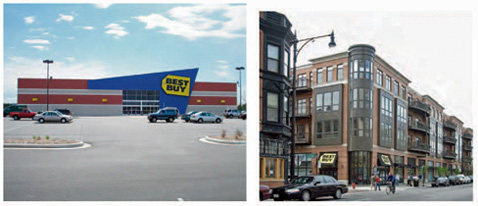Read an excerpt from this article below. You can download the full article by using the link at the end of the excerpt.
For more than 50 years retailers have favored the commercial strip: a linear pattern of retail businesses strung along major roadways, characterized by massive parking lots, a plethora of big signs, box-like buildings, and a total dependence on automobiles for access and circulation.
For years urban planners and public officials have tried to contain, control, and improve the strip. Now they are getting some help from an unexpected quarter: consumers and the marketplace. Today the era of strip development is coming to an end. Evolving consumer behavior, changing demographics, high priced gasoline, internet shopping, the economy, and other factors are all combining to create a new paradigm for commercial development.

Commercial strips are not going to disappear overnight, but it is becoming increasingly clear that strip retail is retail for the last century. The future belongs to town centers, main streets, and mixed-use development. Among the reasons for this transformation:
1. We’re Overbuilt on the Strip
From 1960 to 2000 there was an almost ten-fold increase in U.S. retail space, from 4 to 38 square feet per person. For many years retail space was growing 5 to 6 times faster than retail sales. Most of this space came in the form of discount superstores on the suburban strip.
The recession made clear that we have too much retail. Strip centers are now littered with vacant stores. By some estimates, there is currently over one billion square feet of vacant retail space. Much of this space is going to have to re-purposed or demolished. In fact, one retail analyst estimates that we need to demolish 300 million square feet of retail space. On the other hand, the only places left with more spending power than stores to spend it in are our cities.
2. Retail is Rediscovering the City
In 2010, Target announced plans to remodel the century-old Carson Pirie Scott department store in Chicago. This landmark building designed by architect Louis Sullivan will be just one of a number of new, so-called big box retailers planned for urban neighborhoods.
Similarly, in late 2010, Wal-Mart announced plans to open its first ever stores in Washington, D.C. To make the four new stores fit an urban environment, the company has agreed to consider an array of layouts, designs, and parking arrangements, a reflection of the chain’s willingness to adapt its prototype to enter lucrative urban markets.
The D.C. store planned for New Jersey Avenue illustrates Wal-Mart’s new approach to store design. The company plans a store of 75,000 to 80,000 square feet (much smaller than usual) on the ground floor of a five story mixed-use building featuring 315 apartments, underground parking, and space for smaller retail stores. Home Depot already has a new urban store in Toronto with 90 units of housing on top.
At the same time that Wal-Mart, Target, and other big box stores are planning dozens of new urban stores in cities all over America, as many as 400 former Wal-Mart stores and other big boxes sit vacant on commercial strips across the country. Most analysts agree that cities and urban neighborhoods are the new land of opportunity for retail. …
McMahon’s article then continues with sections on:
3. The Suburbs are Being Redesigned
4. Traffic Congestion, Fuel Prices, and Poor Design are Hurting the Strip
5. The Economy is Restructuring the Retail Landscape
6. Consumers Favor Walkability and Places With Character
7. E-Commerce and New Technologies Mean Fewer and Smaller Stores
plus: Where Do We Go From Here? — what can planning commissions do to help reshape the strip; some recommendations culled from leading experts.
Ed McMahon is one of the country’s most incisive analysts of planning and land use issues and trends. He holds the Charles Fraser Chair on Sustainable Development and is a Senior Resident Fellow at the Urban Land Institute in Washington, DC. McMahon is a frequent speaker at conferences on planning and land development.
Over the past 21 years, we’ve been pleased to have published more than two dozen articles by McMahon in the Planning Commissioners Journal, and now on PlannersWeb.com.